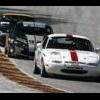Grrr....most post didn't save.
My name is Tom, two (too).
All of the above. Pressure, pressure increase, wear patterns...especially differences between tires. Not that perfectly even pressure growth is NOT the goal, but if something is wildly different, and I had a handling problem that'd be where I'd start. Lap time rules, though. As Saul has said in other threads...."If flipping a brake pad backwards is faster, well....then do that!" So, faster is as faster does.
So, if you've got a corner that's growing 9psi, and everything else is +6....and you've got a handling problem that's related to that corner...then maybe a change is in order (cross or arb) to take some pressure off that tire.
I've taken to recording my tire pressures on my windshield through the day (hot and cold in different colors). I find it really handy to be able to just stare at the car, and see the patterns in pressures over a day's sessions while trying to decide what to do.
When I check tire pressure, they are all within 1-2 lbs, which I had always assumed to be 'normal'. Let's say for instance I get a +9 vs a +6, that's tells me that tire is working harder/sliding more? Then what does that tell me, to adjust something in the set-up, or perhaps driving style. I also assume it matters if F/R and/or Dominate/Non-Dominate side.
What Toyo hot pressure should I be shooting for




 Sign In
Sign In Create Account
Create Account





 Back to top
Back to top Report
Report









